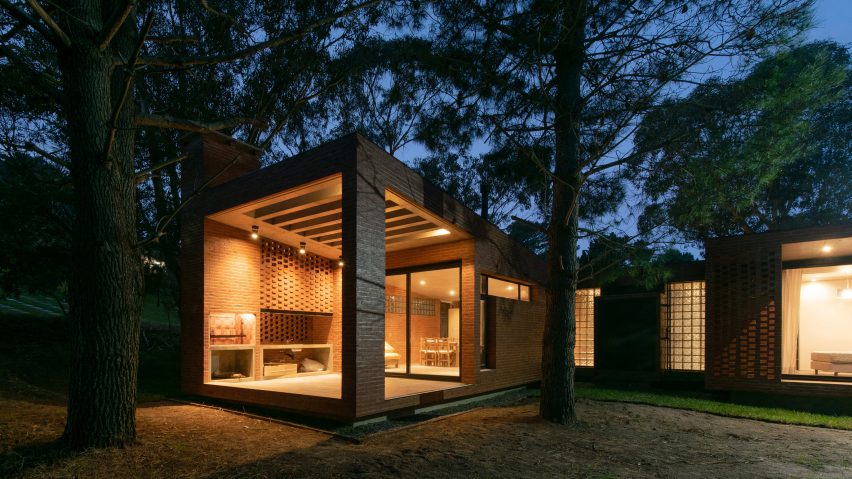This brick holiday home by Argentinian architecture firm Estudio Galera, in a seaside town south of Buenos Aires, references the "formal and material austerity" of the surrounding properties.
The 115-square-metre Casa Rincón is the first of six rental houses intended for a plot measuring 619.5 square metres in Ostende – a coastal town in Buenos Aires' Pinamar County that dates back to the early 20th century.
According to Estudio Galera, Ostende town once experienced a "time of great splendour" as a hot tourist spot. It has since lost out in popularity to three others nearby: The Pinamar, Valeria del Mar, and Cariló – where the firm is based.
"Ostende thus turned into the city with the largest permanent living population – mostly, working class – of the county," said Estudio Galera in a project statement.
"Its geographical, historical and social features are portrayed in an architecture that reflects contemporaneity with signs of formal and material austerity."
For the rental development, which is hoped to spark a revival in the area, Estudio Galera was challenged to develop a concept that could suit the different topographies of the six lots, as well as "a generic user".
In response, the team designed a simple layout comprising two linked volumes of vastly different sizes. They chose materials and details, such as brickwork and the sloped roof, to draw a likeness to the properties in the vicinity.
"The house forges a bond with its surroundings," said Estudio Galera. "The existing residences represent the popular brick chalet of Pinamar in the 1980s and mid 1990s, characterised by a principal body with exposed raked-joint bricks, wood millwork and big sloped roofs."
"Casa Rincón redefines this style and adjusts the materiality to current technology," the team added.
In addition to its look, the brick provided a cost-effective solution for the architects, who sourced the material locally and used local builders.
"Its monolithic appearance creates a formal simplicity of great visual value," Estudio Galera said. "Furthermore, the fact that local craftsmen dominate the masonry trade contributed to the choice of common bricks as the main material in the construction."
Bricks are laid out in different patterns to "create games of lights and shadows", as well hide service elements. In some walls, the bricks protrude out at different lengths, while gaps feature in others.
Long windows filled with patterned glass blocks break up the extensive brickwork and create a dappled lighting effect inside, while maintaining guests' privacy.
The sloped roof atop the two volumes bends inwards towards the middle, forming an inverted pitch. The shape is intended to open up the large windows at the end to natural light and views of the surrounding land, which the team describes as "an important aspect of the project".
"This space consists of a garden of aged trees – rare in a sand dune environment – which was left unaltered to provide a 'natural shelter' for leisure," it said.
On the north-west end of Casa Rincón's larger block, the studio created a covered dining outdoor area to benefit from the elevated roof height. A barbecue and a sink can be used for preparing food, with sliding glass doors leading into the open-plan living and kitchen space inside.
Large grey floor tiles run from the patio throughout the interiors to provide a continuity between the two, and are among a series of pared-back finishes that feature inside.
Others include a series of polished-concrete and pale-wood fittings that make up the kitchen counters and a storage unit, which wraps around the wood burning stove in the lounge.
Similar designs also form a long bench that runs down a hall leading to the other end of this block, where the main bathroom and two bedrooms are located.
The master bedroom occupies the smaller volume, with sliding glass doors that open onto a slender patio facing the garden.
Casa Rincón is raised above the ground slightly to protect the masonry from weathering caused by water.
It was built with a cavity wall structure, which the team said helped to reduce its costs. This involves walls built in two layers bolster the structure, with the air gap between providing space for insulation and a waterproofing material.
The coast around the Argentinian capital offers several popular vacation spots for city dwellers. In another seaside resort just north of Casa Rincón, Buenos Aires-based studio Besonías Almeida Arquitectos has completed a holiday home with board-marked concrete walls and overhanging roofs.
Photography is by Diego Medina.
Project credits:
Architects: Ariel Galera, Cesar Amarante, Francisco Villamil. Architect
Structural engineer: Javier Mendia
Surveyor: Claudio D´eramo
Landscaping: Pasesaggio

